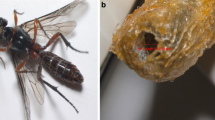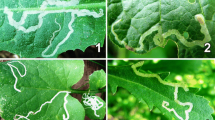Abstract
A study was conducted in Burkina Faso from 1991 to 1994 on the parasitoids associated with the following lepidopterous pests of cotton:Helicoverpa armigera (Hübner),Earias spp.,Diparopsis watersi (Rothschild),Spodoptera littoralis (Boisduval),Syllepte derogata (F.) andAnomis flava (F.). Thirty-nine primary parasitoid species and ten secondary parasitoid species were collected. The mean annual parasitism rates were lower than 20%, except forS. derogata pupae (42.9%). Maximum weekly parasitism rates could be high, with 61.5% recorded forS. derogata pupae and 32.9% forH. armigera larvae. The highest parasitism rates were found forMeteorus laphygmarum Brues (Braconidae) onH. armigera, Xanthopimpla aliena Krieger (Ichneumonidae),Brachymeria olethria (Waterston) andB. citrea (Steffan) (Chalcididae) onS. derogata, Aleiodes dedivus (Szépligeti),Dolichogenidea sp. (Braconidae) andBrachymeria feae Masi onEarias spp., an unidentified Tachinidae onA. flava andMetopius discolor Tosquinet (Ichneumonidae) onS. littoralis. Secondary parasitoids are mainly associated withApanteles spp. (Braconidae) which parasitizeS. derogata larvae. Some species of these secondary parasitoids such asNesolynx phaeosoma (Waterston),Pedobius amaurocoelus (Waterston) (Eulophidae) andAphanogmus fijiensis (Ferrière) (Ceraphronidae) may also attack certain Braconidae or Chalcididae that are primary parasitoids of other lepidopterous pests.
Résumé
Une étude des parasitoïdes des ravageurs du cotonnier au Burkina Faso a été menée entre 1991 et 1994 sur les genres ou espèces de lépidoptères suivants:Helicoverpa armigera (Hübner),Earias spp.,Diparopsis watersi (Rothschild),Spodoptera littoralis (Boisduval),Syllepte derogata (F.) etAnomis flava (F.). Trente-neuf parasitoïdes primaires et dix parasitoïdes secondaires ont été observés. Les taux de parasitisme moyens annuels sont inférieurs à 20%, hormis pour les chrysalides deS. derogata (42,9%). Les valeurs maximales des taux hebdomadaires de parasitisme peuvent être élevées: 61,5% pour les chrysalides deS. derogata ou 32,9% pour les chenilles deH. armigera. Les taux maxima de parasitisme les plus élevés ont été obtenus avecMeteorus laphygmarum Brues (Braconidae) surH. armigera; Xanthopimpla aliena Krieger (Ichneumonidae),Brachymeria olethria (Waterston) etB. citrea (Steffan) (Chalcididae) surS. derogata; Aleiodes dedivus (Szépligeti),Dolichogenidea sp. (Braconidae) etBrachymeria feae Masi surEarias spp.; un Tachinidae indéterminé surA. flava; Metopius discolor Tosquinet (Ichneumonidae) surS. littoralis. Les parasitoïdes secondaires sont essentiellement associés auxApanteles spp. (Braconidae) parasitant les larves deS. derogata. Parmi ces parasitoïdes secondaires, certaines espèces, telles queNesolynx phaeosoma (Waterston),Pedobius amaurocoelus (Waterston) (Eulophidae) ouAphanogmus fijiensis (Ferrière) (Ceraphronidae), sont susceptibles de s’attaquer également aux Braconidae ou aux Chalcididae parasites primaires des autres lépidoptères.
Similar content being viewed by others
References
Bagayoko, B., Michel, B. &Togola, M. — 1993. Synthèse des connaissances sur le peuplement arthropodien associé au cotonnier au Mali. —IER, Sikasso, 23 pp.
Coaker, T. H. — 1959. Investigations onHeliothis armigera (Hübn.) in Uganda. —Bull. Entomol. Res., 50, 487–506.
Couilloud, R. — 1987. LesEarias du cotonnier.Earias insulana (Boisduval) etE. biplaga Walker, en Afrique. —Cot. Fib. Trop., 42, 283–303.
Deguine, J. P. — 1991.Anomis flava (Fabricius, 1775) (Lepidoptera, Noctuoidea, Noctuidae, Ophiderinae). —Cot. Fib. Trop., 46, 105–142.
Galichet, P. F. — 1964.Diparopsis watersi Rothschild, Lepidoptera, Noctuidae, ravageur du cotonnier en Afrique Centrale. —Cot. Fib. Trop., 19, 437–472.
Giret, M. &Couilloud, R. — 1986. Remplacement de l’agar-agar par un gélifiant à base de carraghenate pour la confection de milieux nutritifs destinés à l’élevage des larves de lépidoptères. —Cot. Fib. Trop., 41, 131–133.
Greathead, D. J. &Girling, D. J. — 1989. Distribution and economic importance ofHeliothis spp. and of their natural enemies and host plants in southern and western Africa. In: Proceedings of the workshop on biological control ofHeliothis: increasing the effectiveness of natural enemies. (E. G. King &R. D. Jackson, eds). —Far Eastern Regional Research Office, U.S. Department of Agriculture, New Dehli, 329–346.
Memmott, J. &Godfray, C. — 1993. Parasitoid webs. In: Hymenoptera and biodiversity (LaSalle &Gauld, eds). —CAB International, Wallingford, 217–234.
Nibouche, S. — 1992. Acariens, diplododes et insectes phytophages associés à la culture cotonnière au Burkina Faso. —Cot. Fib. Trop., 47, 305–311.
Nibouche, S. &Gozé, E. — 1993. Efficacité et rentabilité de la protection phytosanitaire vulgarisée en culture cotonnière au Burkina Faso. —Cot. Fib. Trop., 48, 177–193.
Nurindah &Bindra, O. S. — 1988. Studies of biological control of cotton pests. —Industrial Crops Research Journal, 1, 59–84.
Nyambo, B. T. — 1990. Effect of natural enemies on the cotton bollworm,Heliothis armigera Hübner (Lepidoptera: Noctuidae) in Western Tanzania. —Trop. Pest Manag., 36, 50–58.
Odebiyi, J. A. — 1982. Parasites of the cotton leaf roller,Sylepta derogata (F.) (Lepidoptera: Pyralidae) in south-western Nigeria. —Bull. Entomol. Res., 72, 329–333.
Parsons, F. S. — 1940. Investigations on the cotton bollworm,Heliothis armigera, Hübn.Bull. Entomol. Res., 31, 147–177.
Parsons, F. S. &Ullyett, G. C. — 1934. Investigations on the control of the american and red bollworms of cotton in S. Africa. —Bull. Entomol. Res., 25, 349–381.
Pearson, E. O. — 1958. The insect pests of cotton in tropical Africa. —Empire Cotton Growing Corporation and Commonwealth Institute of Entomology, London, 355 pp.
Reed, W. — 1965.Heliothis armigera (Hb) (Noctuidae) in western Tanganyika. II. Ecology and natural and chemical control. —Bull. Entomol. Res., 56, 127–140.
Silvie, P. — 1990.Syllepte derogata (Fabricius, 1775) (Lepidoptera, Pyraloïdea, Crambidae, Spilomelinae). —Cot. Fib. Trop., 45, 199–227.
Silvie, P. — 1991. Effet du parasitisme naturel observé chez deux lépidoptères phyllophages du cotonnier:Syllepte derogata (Crambidae) etCosmophila flava (Noctuidae). —BioControl, 36, 431–441.
Silvie, P. — 1993. Les parasitoïdes deSyllepte derogata (Fabricius, 1775) (Lepidoptera, Crambidae) au Togo. —J. Afr. Zool., 107, 363–372.
Silvie, P., Delvare, G. &Maldes, J. M. — 1989. Arthropodes associés à la culture cotonnière au Tchad: ravageurs, prédateurs et parasites. —Cot. Fib. Trop., 44, 275–289.
Silvie, P., Delvare, G., Aberlenc, H. P. &Sognigbe, B. — 1993. Contribution à l’inventaire faunistique du cotonnier au Togo dans une optique de lutte intégrée. —Cot. Fib. Trop., 48, 313–322.
Sivakumar, M. V. K. &Gnoumou, F. — 1987. Agroclimatologie de l’Afrique de l’Ouest: le Burkina Faso. —ICRISAT, Patancheru, 61 pp.
Townes, H. & Townes, M. — 1973. A catalogue and reclassification of Ethiopian Ichneumonidae. —Memoirs of the American Entomological Institute, 19, 416 pp.
van den Berg, H., Cock, M. J. W., Oduor, G. I. &Onsongo, E. K. — 1993. Incidence ofHelicoverpa armigera (Lepidoptera: Noctuidae) and its natural enemies on smallholder crops in Kenya. —Bull. Entomol. Res., 83, 321–328.
van den Berg, H., Waage, J. K. &Cock, M. J. W. — 1988. Natural enemies ofHelicoverpa armigera in Africa. A review. —CAB International Institute of Biological Control, Ascot, 81 pp.
Author information
Authors and Affiliations
Rights and permissions
About this article
Cite this article
Streito, J.C., Nibouche, S. First observations on the parasitoids associated with lepidopterous pests of cotton in Burkina faso. BioControl 42, 543–557 (1997). https://doi.org/10.1007/BF02769814
Received:
Accepted:
Published:
Issue Date:
DOI: https://doi.org/10.1007/BF02769814




